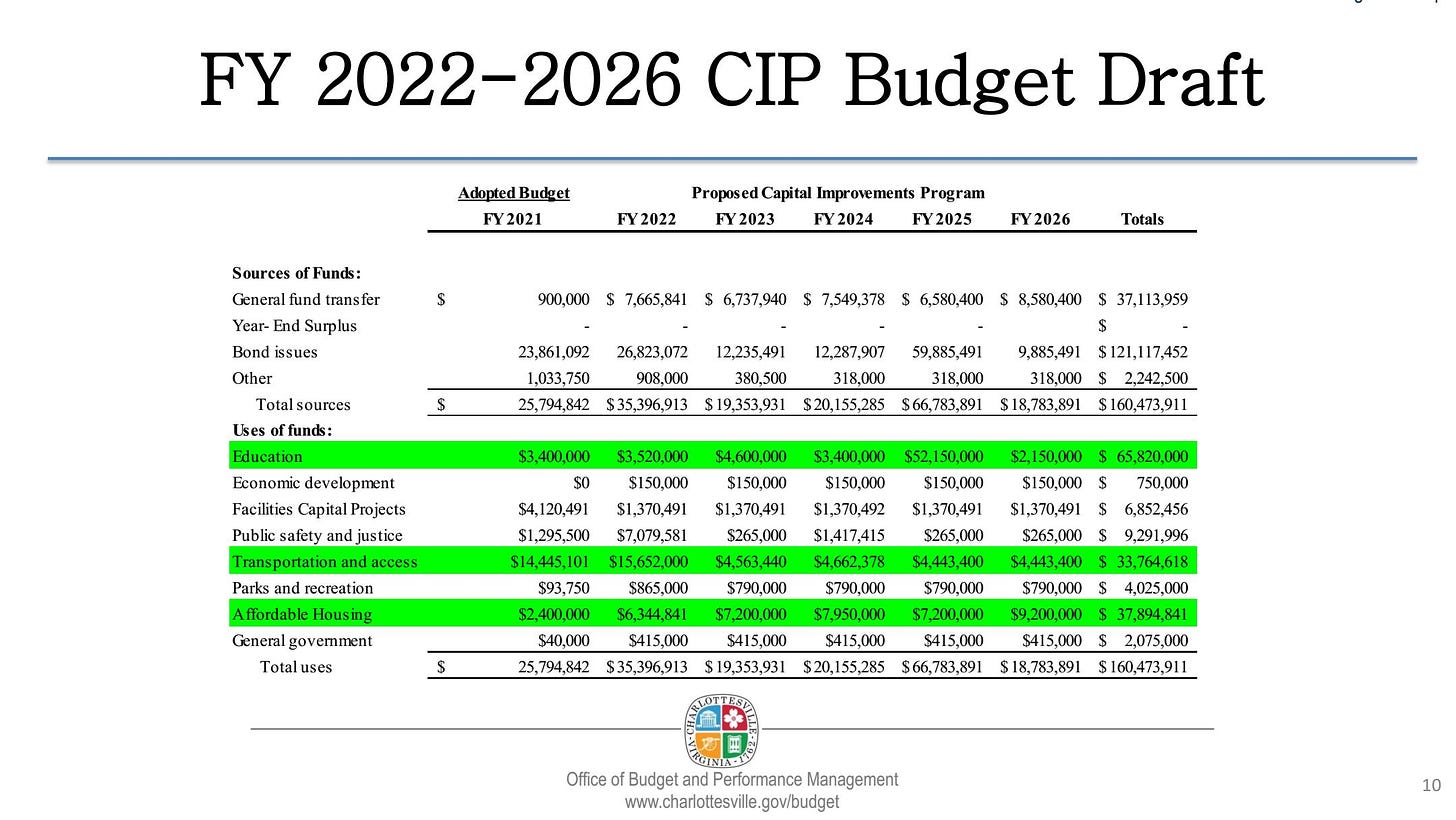Today's Patreon-fueled shout-out is for the Plant Northern Piedmont Natives Campaign, an initiative that wants you to grow native plants in yards, farms, public spaces and gardens in the northern Piedmont. Native plants provide habitat, food sources for wildlife, ecosystem resiliency in the face of climate change, and clean water. Start at the Plant Northern Piedmont Natives Facebook page and tell them Lonnie Murray sent you!
On today’s show:
The population of the Charlottesville area has grown by over ten percent in the past ten years
The Thomas Jefferson Planning District Commission says goodbye to Chip Boyles
Charlottesville City Council discusses the capital improvement budget
In six days, Chip Boyles will officially become Charlottesville’s City Manager. Last Thursday, the Board of Commissioners of the Thomas Jefferson Planning District Commission said goodbye to Boyles in his capacity as their executive director. He has been there since April 2014. Greene County Supervisor Dale Herring is Chair of the TJPDC Board and he read from a proclamation.
“Whereas the influence and reputation of the TJPDC and the quality of programs and services during Chip’s tenure has been greatly enhanced by the vision, skills, and passion he brought to TJPDC’s mission, therefore be it resolved that the Thomas Jefferson Planning District Commission expresses enduring gratitude and appreciation for the generous and faithful service provided to the TJPDC and this region by Chip Boyles.”
Commissioner Keith Smith of Fluvanna County said Boyles took over at a time when the TJPDC had opted to not renew the contract of a previous director.
“We were in a bad way and just to do a 180, it was purely upon his skill, his leadership, and that funny accent of his, people apparently trust him,” Smith said. “Who knew?”
Charlottesville City Councilor Michael Payne said he appreciated the comments from other TJPDC Commissioners.
“I’m just incredibly excited to work with Chip going forward and I think there are really bright days ahead for the region as a whole,” Payne said.
Nelson County Supervisor Jesse Rutherford praised Boyles’ optimism but also made a threat in jest.
“Michael and you all, I’m just saying,” Rutherford said. “My threat out there of saying that if this doesn’t go well, we will ban all fruit products and beverages from going into Charlottesville from Nelson County. That’s a serious one and whoever the reporter is in here, write that down!”
Rutherford also sounded a more positive tone.
“We look forward to the success of Charlottesville,” Rutherford said. “That is not only important to Nelson County but the region. I can’t say this enough, but we have sent you our best, alright?”
One of TJPDC’s achievements with Boyles in charge is the creation of the Regional Transit Partnership, a gathering of various agencies that has spent the last few years laying out the foundation for a more integrated system. Recently the Virginia Department of Rail and Public Transportation (DRPT) awarded TJPDC a grant to help build more of the framework.
“This award is $175,000 for the development of a regional plan as recommended by the Regional Transit Partnership,” Jacobs said. “There is a match for this of $175,000 to be provided both by Albemarle County and the city of Charlottesville over two fiscal years.”
This plan will involve coordination between Charlottesville Area Transit, the University Transit Service, JAUNT and Albemarle County. The DRPT also awarded a $106,500 grant to TJPDC to study expansion of transit in Albemarle. The county will have to pay half of that as a match.
“This study is to develop the financial feasibility of new transit services in three different areas,” Jacobs said. “Route 29 north, Monticello, and Pantops.”
The TJPDC also coordinates regional priorities for Community Development Block Grants. Applications to the Virginia Department of Housing and Community Development from non-urban localities are due on March 26.
“As of the end of January, we’ve already been notified of one project in Louisa County for a planning and infrastructure grant for affordable housing,” Jacobs said. “We know of a Nelson County potential grant for downtown revitalization of Lovingston. We have Albemarle County acquisition and redevelopment for an affordable housing project. And Scottsville has a redevelopment project going on.”
The Virginia DHCD is now directly administering a rent and mortgage relief program to assist households during the pandemic, but the TJPDC was in charge of the program in the second half of calendar year 2020.
“We were awarded a total grant of $1.8 million dollars for the region [and] $1.624 million of that went directly to pay for rent and mortgage relief for qualifying families,” Jacobs said. “That was 570 families in this region who were served with an average of $2,000 rent per household.”
The state program is not covering additional mortgage payments at this time, but are still accepting applications for rent relief. Visit their website if you or someone you know needs assistance.
Locally, the TJPDC has launched an online portal called Porch Light that allows people to find affordable housing opportunities.
“If you know people who have rental properties, direct them to our website and they can go directly to the site,” Boyles said. “We need landlords to list their properties. It’s free. It’s easy.”
Nelson County Supervisor Rutherford said the COVID pandemic has brought a real sense of urgency about housing.
“We’re going to be doing some hard soul-searching in Nelson County and what it is we can do to get some economies of scale and some more dense housing,” Rutherford said.
Rutherford said he is aware that some newcomers to the area are choosing Nelson due to the provision of more broadband Internet. He said he has a tenant who works in Crystal City and commutes twice a week.
“We’re going to see some major culture changes in our workforce and in how we operate on a business level,” Rutherford said.
(watch the whole TJPDC meeting here)
Population estimates published
The Weldon Cooper Center at the University of Virginia has released its annual population estimates for localities across the Commonwealth. Albemarle County has grown by 11.7 percent since the 2010 Census, with an estimated population of 110,545 as of July 1, 2020. The population of the City of Charlottesville increased by 13.8 percent to a population of 49,477.
There are also increases in most other localities in the Thomas Jefferson Planning District. Fluvanna County jumped 5.9 percent to 27,202. Greene County is estimated to be at 20,323, or an increase of 10.4 percent. Louisa County increased by 11.6 percent to a population of 37,011 people. Only Nelson County is estimated to have declined over the past ten years, losing just over a hundred people to 14,904 people.
When added all together, the planning district as a whole increased 10.5 percent to a total population of 259,432. Other planning districts that experienced that level of growth include Northern Virginia with 13.5 percent growth, the Rappahannock-Rapidan with 8.7 percent, the Richmond Regional at 10.6 percent, the Crater District at 7.7 percent and the George Washington Regional Commission at 14.9 percent.
The U.S. Census Bureau, however, organizes localities into Metropolitan Statistical Areas. The Charlottesville MSA is similar to the Planning District, with the exception that Louisa County is replaced with Buckingham County. When viewed that way, the MSA grew by 10.4 percent. Buckingham County remained flat in the Weldon Cooper estimate with an increase of just 16 people.
The U.S. Census results are expected to be posted later in the year, later than the usual release date of April 1.
Charlottesville Council discusses capital budget at Feb. 3 work session
Later on today, the Charlottesville Planning Commission will meet with the Charlottesville Planning Commission to discuss the Capital Improvement Program (CIP) for the next fiscal year which begins on July 1, 2021. Last week, Council discussed the proposed $160 million CIP for the next five years. When they adopt a budget in April, Council will only approve actual funding for FY22 but looking ahead to the full five-year period helps give budget planners perspective about what capacity the city has incur more debt to cover capital projects.
“If you look at sort of a ten year history, you will see that in 2012 our CIP was at $80 million,” said Krissy Hammill, a senior budget analyst with the city. “It ebbed and flowed until about 2017 but we still hovered around the $80 million mark. Since 2018, the CIP from 2017 to now, this draft, our five-year CIP has basically doubled.”
Hammill said Council increased the amounts for affordable housing from $8 million in the 2012 five-year plan to $38 million in the current draft. Additional spending was allocated for education and transportation.
“Of those three priority areas, we’ve essentially added $94 million of funding to a plan, of course the big chunk being the $50 million for the school reconfiguration,” Hammill said. “But I think it shows that in some respects with regard to the CIP plan, we’ve put the money where our priorities were, but we’ve also done that without taking anything away.”
A $6 million city contribution for a joint General District Court with Albemarle is in the plan as is $10 million for a parking garage at 9th and Market Street to support the expanded courts complex.
The draft CIP contemplates issuing $121 million in bonds over the next five years to fund some of the projects, including about $74 million in projects already authorized by previous Councils. Hammil said that will come close to maxing out the city’s debt capacity for the foreseeable future. It will also cost the city more.
“If we get to a point where we’re issuing $185 million or $195 million worth of debt, the debt service doubles,” Hammill said. “So you’re going to go from a debt service payment of roughly $11 million of $22 million.”
That will likely require a tax increase to cover that additional payment, or the equivalent reduction in spending. There is currently no tax increase anticipated for the next year, but Hammil said they would need to plan for one soon should they decide to proceed with the full capital improvement plan.
Council made no major decisions at the work session last week but did offer glimpses of their thoughts in a discussion.
Councilor Payne said he would support deferring or canceling the $10 million for the parking garage and working to find another solution to guarantee parking for the courts complex.
“I think we really need to at least initiate conversations on are there ways to meet that courts agreement outside of a new parking garage of that size and cost,” Payne said. “Not abandon that agreement. Meet it. Honor it. Honor our relationships and commitments with the county but see what we can do reduce that cost there.”
Councilor Lloyd Snook said he was also willing to rethink the garage.
“I’ve been a real passionate defender of this parking garage but as someone who uses the parking garage that we have now, I’m looking around and seeing we don’t have a demand for parking right now,” Snook said. “Admittedly things are slow because of COVID, but we don’t know when that will end.”
Payne said the city also needs to have a conversation about the full cost of middle school reconfiguration. Mayor Nikuyah Walker said she and Councilor Heather Hill sit on a committee with two school board members who are working on the issue while a cost estimate is developed.
Walker said whatever the conversation, the focus must be on equity. She also said the city’s spending on housing must be tracked. The city is currently without a housing coordinator.
“I don’t know where we are on replacing [John] Sales’ position,” Walker said. “I think it was Jeff Levien last time he was before us said there was still a vacant unit sitting in [Six Hundred West Main] because he could not find anyone to rent it.”
Walker said she is also concerned about the future of the city’s investment in Piedmont Housing Alliance’s redevelopment of Friendship Court.
“We make decisions based on relationships and not based on what people would do,” Walker said. “We are taking taxpayer money and investing those dollars and we should have some strings attached.”
Staff has recommended not proceeding with additional funding for the West Main Streetscape, which has a roughly $52 million cost estimate to implement a design plan that cost $2.85 million in city funds to create. One Councilor was ready to de-prioritize local funds being use to move forward.
“I do see the value and vision,” Payne said. “I just can’t justify it as being a bigger priority than these other things,” Payne said.
The West Main project was split into four phases in order to secure funding from the Virginia Department of Transportation. Local funding is required for Phase 1 and Phase 2, but a third phase is being recommended for nearly $10.9 million in funding in the next Smart Scale round. I asked the Virginia Department of Transportation plan what would happen if Council decides to cancel the first two phases. Phase 3 covers the area between the Drewary Brown Bridge and Roosevelt Brown Boulevard.
“The Phase 3 application would not be automatically removed,” said VDOT spokesman Lou Hatter. “It is a standalone project. From the process perspective the City would need to pass a resolution requesting that its Phase 3 application be withdrawn from consideration for funding.”
Hatter said if the city does drop Phase 3, the funding would go to the next highest scoring project in Smart Scale, which is a roundabout at the intersection of Route 522 and Route 20 in Orange.
Councilor Snook said he did not want to make a decision at the work session, and consensus was reached to do so at Council’s upcoming meeting next Monday.



















Share this post